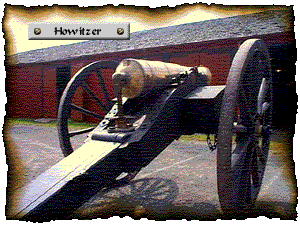
They were developed later than either the gun or the mortar but were in use in the British service during the Napoleonic Wars. The Howitzer was actually a cross between a gun and a mortar having the ability to fire a reasonably large projectile but without the immobility of the mortar or the weight of the gun. For example, a 12-pounder brass gun weighs about 18 cwt., whereas a 12-pounder brass howitzer weighs only 6.5 cwt.

Howitzers are usually distinguished by their calibers expressed in inches; but there are three brass howitzers, 32-pounder, 24-pounder, and 12-pounder, named after the guns whose bores have the same diameter. Howitzers are from 5 to 10 calibers in length with their trunnions placed in similar position as a gun.
The Howitzer was designed to fire only shells at various elevations up to 15 degrees. The shell could be equipped with a fuse and exploding charge. Howitzers, with the advantage of a high trajectory, could fire over the heads of friendly troops and could fire over obstacles at the target end of their trajectory. They could also be fired to a limited extent from behind cover, although it must be remembered that there was no system of indirect fire. Larger Howitzers (8- and 10-inch) were reasonably effective up to 2,000 yards while the smaller Howitzers were effective only up to about 1,000 yards.
![]()